Qumran was made famous in recent years as the place where the Dead Sea Scrolls (this book looks as if it might give you some useful information and is relatively cheap) were found. It was a community around the time of Jesus and there is a chance he lived and studied there. They spent a lot of time studying the Torah and took some of the precepts fairly seriously so they had ritual baths twice a day.
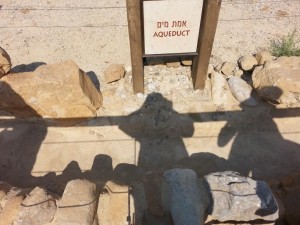
I can’t say too much about Qumran as I get all emotional. We spent a bit of time at the Israel Museum with a good display of some of the artefacts they found along with the scrolls and also some fragments. A museum at Qumran was useful in explaining every day life. I tried to read all the fragments but found tears and a lack of time getting in the way.
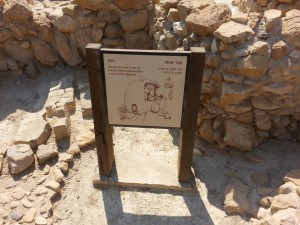
They would have made much of their own equipment, hence the kiln you see in the photo above. I’m sure it had much more structure at that time but as the Romans destroyed the community in 68 CE (Common Era) much of the structure of the buildings was destroyed.
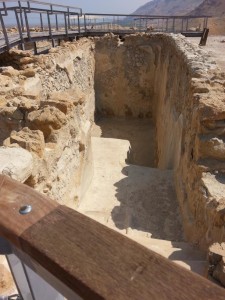
The photo above is a Mikveh or ritual bath. It would have been filled with natural water such as rain water and they would have used it twice a day in order to remain clean and ritually pure. Don’t ask me what was in their hearts and minds but at least their bodies were pure.
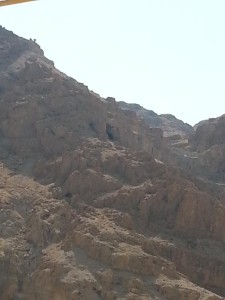
There were many caves in the area and by now I’m sure they’ve all been explored. This photo shows just a couple of them with varying sized entrances. Some of them could be seen from the road and while we were driven down to Kibbutz Ein Gedi, only a couple of days previously, I managed to get a decent photo of one and I put that up as my Facebook profile photo to make people green.
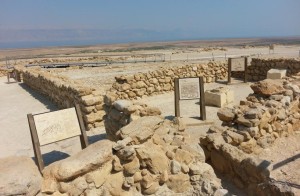
This is Qumran looking towards the Dead Sea. Past the Dead Sea you can see Jordan. Having lived in Australia all my life I’m gobsmacked by how close the countries are to each other in other areas of the world. I spent a lot of time in one country look at another, we were at the top of Mt Nebo looking across at Israel, standing in the same place Moses stood when he knew he’d never get to the promised land, I’ll try to include a photo of that in due course. At one stage we could see the UN compound and past that we could see Syria, only a couple of kilometres from where we were standing in Israel. All of this is something we can’t do in Australia, our country is so vast but we share absolutely zero borders with any other country and we can’t see another country from our borders.
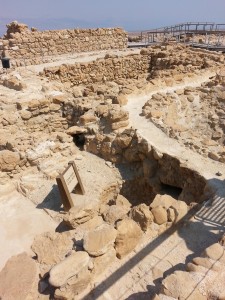
The photo above gives you some idea of the size and structures they had built in Qumran. They had some fairly sophisticated buildings with really decent walls and I presume they had roofs as well. It looks really hot here because it was, this is the day we did Masada and the Dead Sea…so much in one day, so much history…way too much for one article…also, it was around 42° degrees Celsius that day.
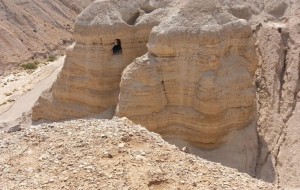
Saving the best till last. This is the cave where they found the Dead Sea Scrolls. The story we were given is that a goat went missing, the goat herd found it in a cave but he couldn’t get down there to retrieve it. He got his father, one of them was let down through the hole in the top (you can just see it at the top of the photo above the hole in the side) and when he was in the cave he found various pottery jars with scrolls in them. These were then sold to someone else who sold them in his turn…some people have made a lot of money from these scrolls. At some stage they were bought by the Israelis who have translated the scrolls and studied them as well as exhibiting them throughout the world. I managed to see them when they were here in Melbourne some years ago. All of this makes it seem as if the scrolls were only found a short time ago but actually the first ones were found in 1947.
There are many stories circulating the internet about some of the information I’ve given here. I can’t say if what I’ve said is true but it’s what I was told and some of it makes sense to me. The rainfall in Qumran is very slight being only about 50 mm per year so they would have made as much of the water as they possibly could. Ritual baths are mentioned in the Torah (Old Testament) and as the community was studying the Torah ritual baths make sense, but do they make sense when they get such little water per year? Excellent question, just remember that they wouldn’t have turned a tap for an individual shower on as we do (I hear one as I write this), the water would have stayed in the bath and many people would have used it multiple times. One source suggests this water was used for drinking as well. Why would you bathe in your drinking water when it’s stagnant? I have more questions than answers, we really need a time machine to answer everything. Where’s the TARDIS when you need it?

